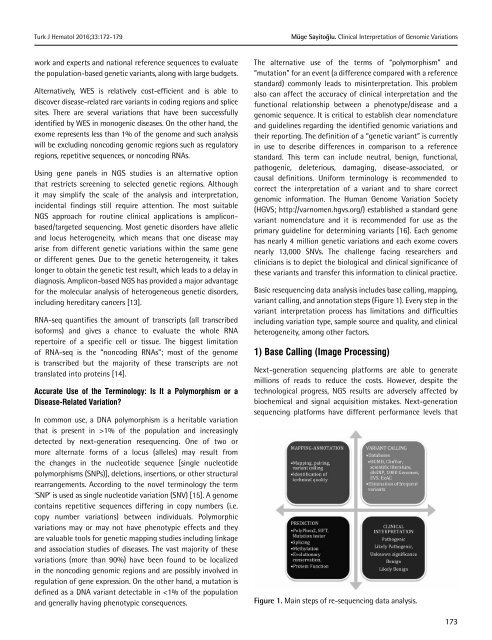Turkish Journal of Hematology Volume: 33 - Issue: 3
Create successful ePaper yourself
Turn your PDF publications into a flip-book with our unique Google optimized e-Paper software.
Turk J Hematol 2016;<strong>33</strong>:172-179<br />
Müge Sayitoğlu. Clinical Interpretation <strong>of</strong> Genomic Variations<br />
work and experts and national reference sequences to evaluate<br />
the population-based genetic variants, along with large budgets.<br />
Alternatively, WES is relatively cost-efficient and is able to<br />
discover disease-related rare variants in coding regions and splice<br />
sites. There are several variations that have been successfully<br />
identified by WES in monogenic diseases. On the other hand, the<br />
exome represents less than 1% <strong>of</strong> the genome and such analysis<br />
will be excluding noncoding genomic regions such as regulatory<br />
regions, repetitive sequences, or noncoding RNAs.<br />
Using gene panels in NGS studies is an alternative option<br />
that restricts screening to selected genetic regions. Although<br />
it may simplify the scale <strong>of</strong> the analysis and interpretation,<br />
incidental findings still require attention. The most suitable<br />
NGS approach for routine clinical applications is ampliconbased/targeted<br />
sequencing. Most genetic disorders have allelic<br />
and locus heterogeneity, which means that one disease may<br />
arise from different genetic variations within the same gene<br />
or different genes. Due to the genetic heterogeneity, it takes<br />
longer to obtain the genetic test result, which leads to a delay in<br />
diagnosis. Amplicon-based NGS has provided a major advantage<br />
for the molecular analysis <strong>of</strong> heterogeneous genetic disorders,<br />
including hereditary cancers [13].<br />
RNA-seq quantifies the amount <strong>of</strong> transcripts (all transcribed<br />
is<strong>of</strong>orms) and gives a chance to evaluate the whole RNA<br />
repertoire <strong>of</strong> a specific cell or tissue. The biggest limitation<br />
<strong>of</strong> RNA-seq is the “noncoding RNAs”; most <strong>of</strong> the genome<br />
is transcribed but the majority <strong>of</strong> these transcripts are not<br />
translated into proteins [14].<br />
Accurate Use <strong>of</strong> the Terminology: Is It a Polymorphism or a<br />
Disease-Related Variation?<br />
In common use, a DNA polymorphism is a heritable variation<br />
that is present in >1% <strong>of</strong> the population and increasingly<br />
detected by next-generation resequencing. One <strong>of</strong> two or<br />
more alternate forms <strong>of</strong> a locus (alleles) may result from<br />
the changes in the nucleotide sequence [single nucleotide<br />
polymorphisms (SNPs)], deletions, insertions, or other structural<br />
rearrangements. According to the novel terminology the term<br />
‘SNP’ is used as single nucleotide variation (SNV) [15]. A genome<br />
contains repetitive sequences differing in copy numbers (i.e.<br />
copy number variations) between individuals. Polymorphic<br />
variations may or may not have phenotypic effects and they<br />
are valuable tools for genetic mapping studies including linkage<br />
and association studies <strong>of</strong> diseases. The vast majority <strong>of</strong> these<br />
variations (more than 90%) have been found to be localized<br />
in the noncoding genomic regions and are possibly involved in<br />
regulation <strong>of</strong> gene expression. On the other hand, a mutation is<br />
defined as a DNA variant detectable in

















